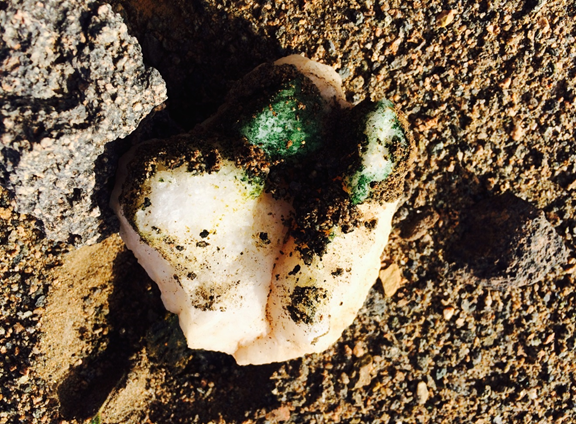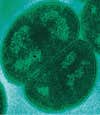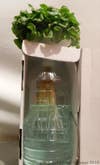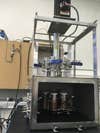Microbes Will Be Essential For Human Survival On Mars
They're a potential source of food, air, clothing, and more. But will they survive the journey, and can we avoid contaminating the red planet?

When humans finally set foot on the dusty terrain of Mars, they will not be travelling alone. Some of the astronauts on future missions will be too small to be seen with the naked eye. But that doesn’t mean they won’t have a vital role to play.
A manned mission to Mars will require shelter, breathable air, clothing, food, medicines, energy, and waste removal, among other services. Many of these needs can be met with living organisms.

“We have been using biology as technology for literally thousands of years, to make our clothing, to make our houses,” says Lynn Rothschild, an astrobiologist and synthetic biologist at the NASA Ames Research Center in Moffett Field, California. “To think that we’re going to do this some other way on Mars is sort of crazy.”
Instead of relying solely of supplies imported from Earth, astronauts could produce some of them on site using microbes. Certain bacteria could take advantage of Mars’s limited resources and support simple ecosystems inside a colony, even helping small plants to grow. They could make oxygen or break down waste. They could be coaxed into producing useful materials, or helping to mine metals.
“We have to use what we find on Mars. I think that we need biology for that,” says Cyprien Verseux, a PhD candidate, supervised by Rothschild, at the University of Rome Tor Vergata.
Life on Mars?
Mars is borderline habitable. This means that bringing microbes is a cause for concern for scientists on the hunt for indigenous life. “It would be an enormous tragedy if it turns out there was a life form there and we contaminated or completely killed it off,” Rothschild says.
And terrestrial microbes could sow confusion if they are later “discovered” by astronauts. “There is a risk that you…are not able to say whether it’s Martian life or not,” Verseux says. “So we really need to make sure that we won’t contaminate Mars with the microbes we use for life support.”
Making sure we explore space responsibly is the preoccupation of NASA’s Office of Planetary Protection (motto: “all of the planets, all of the time”) and the international Committee on Space Research (COSPAR).
Regulations on Martian missions are stricter than those applied to lunar and asteroid-bound spacecraft. Those bodies are unlikely to harbor life. But “going to Mars, which may have habitable environments, you have to be very conservative until you know otherwise,” says Margaret Race, a senior scientist at the SETI Institute in Mountain View, California, who works on planetary protection.
The policies that will govern manned missions to Mars have not yet been set. “There aren’t any firm answers,” Race says. “If somebody wanted to introduce [microbes] on purpose right now they would not be able to do it.”

Regardless, when astronauts reach Mars, they will be bringing microbes along for the ride. “We all have a human microbiome; if you send humans you can’t sterilize them first,” Race says.
One way to limit contamination would be to apply special protections to areas where indigenous life is most likely to thrive. Another would be to modify our microbes’ DNA so it could not be “read” and incorporated by Martian organisms.
The international community is still considering how best to plan missions that deliberately bring human and other life to Mars. “Nobody’s out to stop this stuff,” Race says. “But we’re saying, as we step forward into areas that are clearly unknown, how do we make sure we do it responsibly?”
Can Earth life survive on Mars?
Technically, we’ve already brought life to Mars. When we launch a probe, our best efforts to sterilize it before it leaves Earth’s orbit are still not 100 percent effective, says Dirk Schulze-Makuch, an astrobiologist at the Technical University of Berlin. “The question is just whether they would have a chance to survive there or not.”
Rothschild, however, notes that it’s unlikely those microbes have flourished and contaminated the red planet. That’s because Mars is an awful place to live, as University of Edinburgh astrobiologist Charles Cockell wrote in 2002.
The low gravity (about 38 percent of what we have on Earth) probably wouldn’t trouble these tiny organisms. And there’s certainly enough sunlight for photosynthesis. But Mars is frigid, with an average surface temperature of -80 degrees Fahrenheit. And the air is thin, with only about 1 percent of the atmospheric pressure found at Earth’s sea level. Our planet has a magnetic shield to help protect us from radiation; Mars does not. Plus, Mars is more desiccated than any Earth locale. “On most of the surface there’s no possibility of liquid water,” says Cockell. “It’s a dry…radiation-baked environment,” he says.
Many microbes can bunk down in a dormant state, and it’s possible that Earth microbes could be blown into a protected area or buried. If they could find their way under a rock, they might be sheltered from the worst cold and radiation. But they would have to pull moisture from the air, or find water in seasonal brine seeps. Martian caves, formed long ago by flowing lava, might also host water and a thicker atmosphere. Another possible sanctuary would be drops of liquid water in Mars’s polar ice.
“The generic thought is that this probably hasn’t happened, and the Earth microbes have been killed,” Schulze-Makuch says. “However, we cannot be certain about it—yes, the Martian surface is hostile but our Earth microbes, you shouldn’t underestimate them either.”
Rothschild agrees. Our microbes “are not likely to take over the planet,” she says, “but I bet they could live there, for short periods of time at least.”
A Martian menagerie
Billions of years ago, tiny organisms called cyanobacteria paved the way for life on Earth. Long before plants existed, cyanobacteria were pumping out oxygen as a byproduct of photosynthesis.
For Rothschild, our oxygen-rich atmosphere is the perfect example of how impressive life is as a technology—and how much potential it has to serve us beyond Earth.

Cement-like material made from microbes
Astronauts could also use cyanobacteria on Mars to make useful materials and to support other valuable microbes and plants. We already rely on microbes to provide us with delicacies such as wine, cheese and yogurt, as well as vital services. “They help us make food, make drugs, they help us recycle waste,” Cockell says. “All those useful benefits would be the case on Mars much as they would be on the Earth.”
Using microbes to manufacture goods on Mars would cut down on the amount of mass we’d need to cart over from our own planet. Escaping Earth’s gravity is tremendously expensive. Merely launching a can of Coke would cost $10,000. And that’s just in orbit, says Rothschild—“you haven’t even gotten to Mars.”
Microbes, however, weigh very little, making them easier to bring to Mars. “Then they would replicate, living off the land, using solar energy just like plants and algae do on the Earth,” Rothschild says. The microbes could use the water, minerals and atmospheric gases already on Mars. “From there you can take the materials that the cyanobacteria produce and start to make everything from plastics to habitats.”

Certain microbes could be put to work making food, oxygen, or fuel, or recycling waste to make nutrients for plants and people. Microbes could also help break down rocks and pull out useful metals (on Earth, “biomining” is already used to harvest gold and copper). When mixed with the right ingredients, other microbes could glue grains of Martian dust together to make bricks for homes.
Microbes would be especially useful if astronauts needed to keep Martian soil for gardening. Inside an enclosure, plants would have to be protected from radiation, and provided with water and a hydroponic solution or fertile soil. “Microbes could transform the elements that are available on Mars into a form that plants can use,” Verseux says.
Astronauts could grow plants for food and oxygen—and as a respite from the endless vistas of red. “It’s a huge psychological benefit to have plants on, for example, the International Space Station,” Cockell says. “It gives people something to look after.”
Animals hog a lot of space and resources, so astronauts would be unlikely to bring them on early missions. But small animals like silkworms, fish and shellfish might eventually be sent.

Building better microbes
Any plant or microbe we take with us won’t have to live on the punishing Martian surface. Astronauts will need shelter from Mars’ cold, dry, irradiated, low-pressure environment, and microbes and plants would be likewise protected.
But there would be advantages to genetically engineering the microbes that astronauts depend on to become hardier than they are on Earth. For one thing, it would be safer; if something goes wrong and the equipment housing them fails, microbes could end up facing extreme conditions after all. Plus, tough microbes are cheaper to house. “The more they are built to thrive in conditions which are close to Mars, the less you have to provide shelter and the less you have to recreate Earthlike conditions,” Verseux says.
Plus, microbes could be engineered to become more effective at their assigned tasks, or to play entirely new roles. “You can start to look at nature as this giant genetic hardware store, and you pull things off the shelf and you put it in your little production organism,” Rothschild says. She is exploring how engineered microbes could be used as “ink” for bioprinters on Mars. This would allow astronauts to produce bespoke tools, smart fabrics, or even replacement organs.

“You’re not going to take a field of cotton or trees or sheep to Mars,” she says. But you could take their capabilities and put them in a more portable organism, like a yeast or bacterium.
One Earthly example of this technique is the antimalarial drug artemisinin. Artemisinin is derived from the sweet wormwood plant, but can also be made with the help of engineered yeast. Tire manufacturers and biotech companies are also working on using yeasts to make rubber, rather than taking it from trees.
Currently, Rothschild has her eye on keratin, a protein found in feathers, nails, hair and skin. Microbes could be engineered to produce keratin, and printed in a pre-determined shape. “Imagine if you had a whole sheet of this material that’s really strong and lightweight and flexible,” she says.
All of our attempts to harness microbes to help astronauts survive might lead to advances for everyone back home. “There’s absolutely no reason you couldn’t use any of these things on the Earth,” Rothschild says.

Perhaps one day, microbes could even help us terraform the surface of Mars by producing oxygen and transforming the soil. What this would mean for life on its surface is an open question (particularly since Mars’s low gravity is likely to pose a problem for larger organisms like trees and people).
“I don’t want people to get the impression that we’re just going to send a Noah’s Ark to Mars,” Rothschild says. Not until we’ve engineered the atmosphere to be thick enough to maintain liquid water and higher temperatures could we even talk about sending animals out without protection, she says.
But all that would be many, many years away. Bringing microbes to serve as life support on Mars is the primary, and more attainable goal.
How are we making it happen?
To make it happen, the first step is to keep surveying the microbes we have here on Earth that thrive in extreme environments such as deserts, deep-sea vents, and Arctic ice.
Astrobiologists look for microbes among the Earth habitats that most resemble Mars, to explore how indigenous life might survive on the Red Planet. These expeditions can also reveal adaptations that could serve Earth microbes when we bring them to Mars.
“You would pick microbes that already exist and see what their limits are and how useful they can be,” Cockell says. “Once you know that you can get some better idea about what you have to try to do to make them better.”

Cockell and his colleagues launch rock-dwelling microbes into low Earth orbit to see how they fare outside of spacecraft. Back on Earth, special chambers can also be used to simulate Martian conditions, including temperature, pressure, dryness, and radiation.
Once a microbe’s hardiness has been confirmed (or enhanced), scientists must figure out how to put them to work using tools and enclosures that take up as little mass and power as possible. One ongoing project is the European Space Agency’s Micro Ecological Life Support System (MELiSSA), which will use communities of bacteria to break down and recycle human waste and the inedible parts of plants.
Scientists are also considering what it will be like for astronauts to actually use these tools on a Martian base. Verseux recently emerged from a dome perched on Hawaii’s Mauna Loa volcano after sequestering himself for a year alongside five other scientists. The HI-SEAS experiment provided him the perfect opportunity to work on using cyanobacteria to help grow plants. “What brought me most insight was dealing with…the very limited resources when it comes to power, water, space, time, energy, and all those things,” he says.
With NASA planning manned missions to Mars orbit in the 2030s, astrobiologists are on track to find and prepare our microbial companions for a future where there will be life on the Red Planet. We are understanding these microbes and how to use them better all the time, Cockell says. “I think they will be ready for human exploration when people finally go to Mars.”
